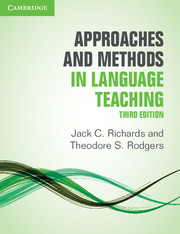Book contents
- Frontmatter
- Contents
- Acknowledgments
- Introduction to the third edition
- I Major trends in twentieth-century language teaching
- II Current approaches and methods
- III Alternative twentieth-century approaches and methods
- IV The teaching and learning environment
- Appendix: Comparison of approaches and methods
- Author index
- Subject index
Introduction to the third edition
Published online by Cambridge University Press: 08 April 2022
- Frontmatter
- Contents
- Acknowledgments
- Introduction to the third edition
- I Major trends in twentieth-century language teaching
- II Current approaches and methods
- III Alternative twentieth-century approaches and methods
- IV The teaching and learning environment
- Appendix: Comparison of approaches and methods
- Author index
- Subject index
Summary
The first two editions of this book were published in the Cambridge Language Teaching Library series, with the first edition produced in 1986 followed by a second edition in 2001. Approaches and Methods in Language Teaching has been widely referred to by teachers and teachers in training for an account of the major teaching approaches and methods that have been used in language teaching from the late nineteenth century to the present day. Despite the advances that have been made in our understanding of language teaching and learning in the last few decades, the language teaching profession continues to explore new instruc-tional designs and pedagogies. Language teaching today reflects the changed status of English as an international language, which has accelerated the demand for more effective approaches to language teaching. Innovations in technology, the growing trend to begin teaching English at primary level as well as the use of English as a medium of instruction in many university programs prompt an ongoing review of past and present practices as teach-ers and teacher educators search for effective activities and resources for their classrooms. And despite the belief that contemporary approaches to language teaching rely less on standard approaches and methods and more on post-method conceptions of teaching – new teaching proposals continue to appear (such as Content and Language Integrated Learning, or CLIL, text- and task-based teaching as well as the Common European Framework of Reference). Familiarity with these as well as with earlier traditions in language teaching are important components of the professional knowledge expected of today's language teachers. For these reasons a third edition of Approaches and Methods seemed appropriate. As we prepared the third edition, we were reminded that not everything that is new is nec-essarily better and that today's teachers could continue to benefit from a text that provides a guide to this rich repository of instructional practices in our field.
A number of changes have been incorporated into the third edition.
• The book is now divided into four parts, with the final part presenting three new chap-ters focusing on approaches and methods in relation to the teaching and learning proc-ess. These chapters seek to show how current views of the roles of learners and teachers in the language teaching process prompt alternative conceptualizations of the status of approaches and methods, and also how approaches and methods can be viewed in rela-tion to the processes of curriculum development.
- Type
- Chapter
- Information
- Approaches and Methods in Language Teaching , pp. ix - xPublisher: Cambridge University PressPrint publication year: 2014

